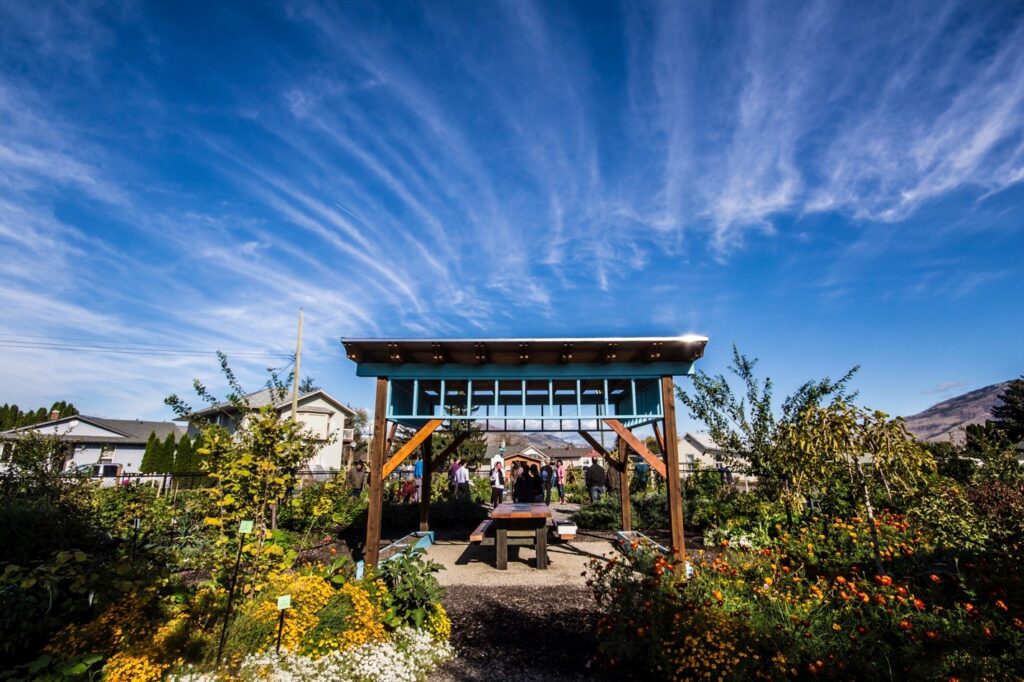The Interior Health Authority (IH) is made up of many diverse communities spanning 215,000 km², each with their own unique health needs. The Healthy Communities Initiative uses a Healthy Communities approach, which builds capacity and empowers communities to improve health outcomes by working together to address the social determinants of health.[1] Read on to learn more about how this initiative works, what IH can do for your community, and how they successfully partnered with Kamloops to create a revamped Official Community Plan that prioritizes community members’ health and well-being.
IH and Healthy Communities
When IH began the Healthy Communities Initiative six years ago, they knew their success would centre around partnerships. However, it takes time to build relationships, and to understand the different needs of the 750,000 people across the communities in IH’s service area, which makes up nearly 25% of the province. It also takes time to demonstrate the quality and depth of the resources IH can provide.
The Okanagan Valley makes up almost half of the interior’s population, and because IH spans such a large area, it includes many rural and small communities as well. With 60 municipalities, 54 Indigenous communities, 10 regional districts, and 16 school districts and communities ranging in population from 195 to 125,000, the region’s health needs are as varied as its settings.
To respond to the unique needs of communities, IH chose to develop the structure of its Healthy Communities Initiative based on the geography and the number of communities in the area. The eight-member team has office locations in Fernie, Kelowna, Vernon, Salmon Arm, and Kamloops. From these sites, team members are able to reach multiple communities across the vast geography.
How does Interior Health collaborate with local governments?
“We’ve always been involved in community health but not the breadth and depth that we are now,” said Mike Adams, Team Leader of Interior Health Healthy Communities Initiative. IH’s work with local governments used to mainly focus on sewage and water, but now they also support food security, affordable housing, poverty reduction, and more.
According to Adams, the following steps guide their work while allowing community health facilitators to remain nimble enough to respond to the needs of each community:
- Build relationships with local government and community partners
- Determine how to work together with local government and community partners
- Connect communities to resources and support community action
- Recognize and celebrate community accomplishments
“You can’t take one approach and apply it unilaterally to every community,” reflected Adams. “It’s important to start relationships by meeting communities where they are at.” Although some relationships have only begun, and others are still being negotiated, persevering with this approach has led to very rich and well-developed relationships.
“Over time,” said Adams, “the Healthy Communities Initiative is receiving support and becoming more prominent. This comes with higher expectations, but there is such a great value to the work that Healthy Communities can offer, like working with partners to integrate health into long-term planning.”
Working with Interior Health
Not every community knows how they’d like to incorporate a health lens at first, but IH works with them to look for common interests and identify projects they can work on collaboratively. Adams explains that the work occurs on a spectrum: one community may have just begun an assessment; while another already has a project underway they’d like input on.
Setting priorities is key, especially for small communities that have less capacity to focus on long-term health interventions. IH works with them to go through a process: visioning, to planning, and then action. They help identify community strengths and align opportunities with local government priorities.
Smaller communities may also require support to apply for grants. Because planners in small communities often wear multiple hats, they may not have the capacity to walk through the application process for funding, so Interior Health’s community health facilitators might help.
“It can be hard to think about something that may have a profound health impact in the long term when you’re running the day-to-day operations of a local municipality. That’s where we can add value and bring the health lens to planning, policy and action,” said Adams.
Case study: Kamloops Official Community Plan
When the City of Kamloops revised its Official Community Plan (OCP), they had an opportunity to improve the future health status of Kamloops residents. IH was happy to work with the City to include some key health issues in their revision:
Encouraging the development of walkable neighbourhoods, especially within mixed-use and neighbourhood centres;
Discouraging private water systems that are external to the municipal water supply;
- Providing information on the City’s website about radon testing;
- Engaging in health indicator discussions for the OCP implementation plan;
- Including tracking and monitoring of food assets as a sub-indicator in the implementation plan; and,
- Linking the OCP to the Healthy Built Environment Linkages Toolkit.
Healthy eating is also important. Public Health Dietitian Laura Kalina recommended specific goals and policies that include access to healthy food. The OCP is supporting a sustainable local food system in urban and suburban areas as well as preserving, enhancing, and promoting local agriculture. It even names community gardens, gleaning, community kitchens, public produce programs, and edible landscapes as examples.
“Food assets are an important part of a City’s healthy build environment,” said Kalina. “We are happy to know the City will monitor and encourage the growth of food assets in our community.”
Want to work with IH to create a healthier community?
IH wants to work with communities to help them improve health and well-being. Although IH partners primarily with municipalities, regional districts, and Indigenous communities, they are also able to support local governments’ healthy community goals in other ways, including participating in committees or helping to mobilize community residents start their own healthy living projects.
If your community is interested in working with IH, you can contact Mike Adams, Team Leader, at Mike.Adams@interiorhealth.ca. The PlanH Health Authority Contacts page has more contact information.
IH also has a monthly healthy communities newsletter that keeps local government partners informed of other work in the region. Contact Mike Adams at the address above to get on the mailing list.
[1] The conditions in which people are born, grow, live, work and age. They are mostly responsible for the existence of unfair and avoidable differences in health status seen within and between groups. The effects of these determinants on health outcomes are much stronger than ones associated with health behaviours such as physical activity, diet, and excessive alcohol consumption. They include: Aboriginal status, gender and gender identity, disability, housing, early life, income and income distribution, education, race, employment and working conditions, social exclusion, social safety net, food insecurity, health services, sexual orientation, and unemployment and job security.




